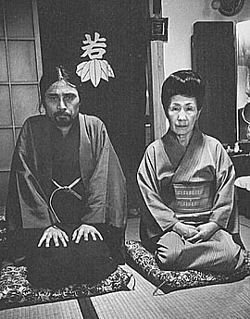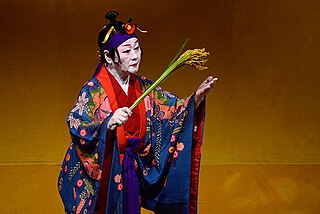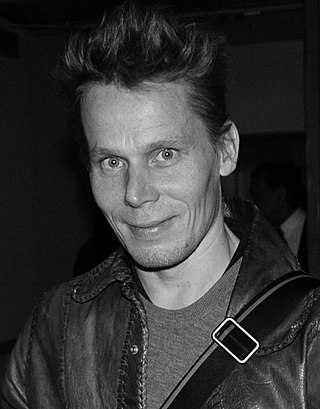
Kabuki is a classical form of Japanese theatre, mixing dramatic performance with traditional dance. Kabuki theatre is known for its heavily stylised performances, its glamorous, highly decorated costumes, and for the elaborate kumadori make-up worn by some of its performers.

The performing arts are arts such as music, dance, and drama which are performed for an audience. They are different from the visual arts, which are the use of paint, canvas or various materials to create physical or static art objects. Performing arts include a range of disciplines which are performed in front of a live audience, including theatre, music, and dance.

Japanese traditional dance describes a number of Japanese dance styles with a long history and prescribed method of performance. Some of the oldest forms of traditional Japanese dance may be among those transmitted through the kagura tradition, or folk dances relating to food producing activities such as planting rice and fishing, including rain dances. There are large number of these traditional dances, which are often subfixed -odori, -asobi, and -mai, and may be specific to a region or village. Mai and odori are the two main groups of Japanese dances, and the term buyō (舞踊) was coined in modern times as a general term for dance, by combining mai (舞) and odori (踊).

Butoh is a form of Japanese dance theatre that encompasses a diverse range of activities, techniques and motivations for dance, performance, or movement. Following World War II, butoh arose in 1959 through collaborations between its two key founders, Tatsumi Hijikata and Kazuo Ohno. The art form is known to "resist fixity" and is difficult to define; notably, founder Hijikata Tatsumi viewed the formalisation of butoh with "distress". Common features of the art form include playful and grotesque imagery, taboo topics, and extreme or absurd environments. It is traditionally performed in white body makeup with slow hyper-controlled motion. However, with time butoh groups are increasingly being formed around the world, with their various aesthetic ideals and intentions.

Contemporary dance is a genre of dance performance that developed during the mid-twentieth century and has since grown to become one of the dominant genres for formally trained dancers throughout the world, with particularly strong popularity in the U.S. and Europe. Although originally informed by and borrowing from classical, modern, and jazz styles, it has come to incorporate elements from many styles of dance. Due to its technical similarities, it is often perceived to be closely related to modern dance, ballet, and other classical concert dance styles.

Expressive dance from German Ausdruckstanz, is a form of artistic dance in which the individual and artistic presentation of feelings is an essential part. It emerged as a counter-movement to classical ballet at the beginning of the 20th century in Europe. Traditional ballet was perceived as austere, mechanical and tightly held in fixed and conventional forms. Other designations are modern dance and free dance, expressionist dance or new artistic dance, in Anglo-American countries German dance. In 2014, modern dance with the stylistic forms and mediation forms of rhythmic and expressive dance movements was included in the German List of intangible Cultural Heritage as defined by the UNESCO Convention for the Safeguarding of Intangible Cultural Heritage. German Expressionist dance is related to Tanztheater.

Tatsumi Hijikata was a Japanese choreographer, and the founder of a genre of dance performance art called Butoh. By the late 1960s, he had begun to develop this dance form, which is highly choreographed with stylized gestures drawn from his childhood memories of his northern Japan home. It is this style which is most often associated with Butoh by Westerners.

Traditional Japanese theatre is among the oldest theatre traditions in the world. Traditional theatre includes Noh, a spiritual drama, and its comic accompaniment kyōgen; kabuki, a dance and music theatrical tradition; bunraku, puppetry; and yose, a spoken drama.
Ballet Philippines (BP) is a ballet company in the Philippines founded in 1969 by Alice Reyes with the support of Eddie Elejar and the Cultural Center of the Philippines. Proficient in both ballet and modern dance, the company synthesizes diverse dance and movement forms into distinctively Filipino contemporary expressions. These include classical ballet, avant-garde choreography, traditional and modern dance, martial arts, and aerial movements.
Dance in Singapore has been an integral part of its culture despite having a relatively short history of creative, artistic and professional dance. The range of dance reflects the cultural diversity of Singapore, from traditional dance forms to contemporary genres.

Sankai Juku (山海塾) is an internationally known butoh dance troupe. Co-founded by Amagatsu Ushio in 1975, they are touring worldwide, performing and teaching. As of 2010, Sankai Juku had performed in 43 countries and visited more than 700 cities.

The Prix de Lausanne is an international dance competition held annually in Lausanne, Switzerland. The competition is for young dancers seeking to pursue a professional career in classical ballet, and many former prize winners of the competition are now leading stars with major ballet companies around the world. The competition is managed by a non-profit foundation organised by the Fondation en faveur de l'Art chorégraphique and is maintained by various sponsors, patrons and donors.

Kumi odori is a form of narrative traditional Ryūkyūan dance. Kumi odori or Kumi wudui means "combination dance" or "ensemble dance".

Kansai Yamamoto was a Japanese fashion designer, most influential during the 1970s and 1980s.

Tero Kalevi Saarinen is a Finnish dance artist and choreographer, and Artistic Director of Tero Saarinen Company. Saarinen has made an international career as both a dancer and choreographer.
National Ballet of Ukraine from the Taras Shevchenko National Opera of Ukraine performs works of classical ballet and tours internationally. It currently has 24 ballets in its repertory, one of the largest in the world, and has had many notable dancers among its members.
The Tokyo Ballet is a classical ballet company, based in Tokyo, Japan, founded in 1964.

Jūrō Kara is a Japanese avant-garde playwright, theatre director, author, actor, and songwriter. He was at the forefront of the Angura ("underground") theatre movement in Japan.
Akira Kasai (1943) is a Japanese butoh dancer and choreographer, who despite being significantly younger than mentors Kazuo Ohno and Tatsumi Hijikata, is considered to be pioneers of the art form along with them. Kasai trained in other forms of dance, but turned to butoh in the 1960s when he met and began to work with these two men. He started his own studio in 1971 but closed it in 1979 to move and study Eurythmy in Germany. He did not dance professionally at the time and for years after his return to Japan in 1986 he stayed off the stage stating that he felt too disconnected from Japanese society to perform. He returned to professional dance in 1994, with the work Saraphita and revived his studio Tenshi kan, now influenced by Eurythmy and other dance principles. He has since performed, choreographed and taught in Asia, the Americas and Europe, but his choreography is sufficiently different from most other butoh that its authenticity has been questioned.
Anzu Furukawa(古川あんず, February 28 , 1952 – October 23 , 2001) was a butoh dancer and performance artist. Since 1973 she has worked as a choreographer, performer and dancer in various groups in Japan including Dairakudakan and Europe.













